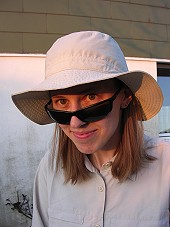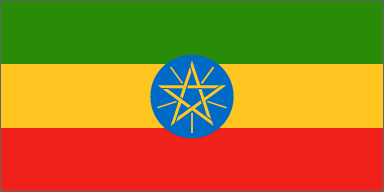
MARTINA'S WORLD TRIP
ETHIOPIA: May 18 - June 1, 2004


(Übersetzungshilfe)
 |
MARTINA'S WORLD TRIP ETHIOPIA: May 18 - June 1, 2004 |
|||||||
 |
||||||||
 |
Your Dictionary
(Übersetzungshilfe) |
|||||||
| Monday, May 24th, 2004 - Omo Valley Tour Day III | |||||||
| Monday, May 24th, 2004 Omo Valley Tour Day III (Turmi)
We woke up very early this morning, which is basically what happens when you go to bed and start your day with the sun, due to the lack of other light sources. As soon as the first person had her head stuck outside the tent, we were greeted by the children we met at the restaurant last night. They invited us to go and see some monkeys near the river which was supposedly close-by. I still hadn’t showered and wasn’t up to it but the guys took off with them. When they weren’t back after more than an hour, I was getting slightly impatient, mainly because I was hungry and wanted to have breakfast. At some point Mike said we should just go but I thought it was pretty impolite to take the car and leave without the others, so I told him we should wait for them. Well, obviously Mike did not quite agree with me because next thing I saw was him getting into the car and taking off without another word, leaving me alone at the camping place. Apart from the fact that I questioned his sense of professionalism as being responsible for me and my safety, I thought it was quite rude to just leave like that, not saying a word about where he went nor when he would be back. As it turned out, we would get used to such strange actions on his part. Xavier, Mohamed and Ihab came back around 10 am. The river and monkeys happened to be about 60 minutes walking distance from the camp, which gave us an idea about the definition of “close-by” in African terms. They said it was a nice place and I should have come but now everybody was starving for breakfast. Annoyed by the fact that we didn’t have a car without Mike, we could do nothing but wait for him to come back, which he did after a while still without any further explanations. We finally went to the restaurant for breakfast and then set off to visit the market in the centre of the village. Turmi is the main town of the Hamer tribe but their famous Monday market also attracts people from other tribes. Not yet a specialist in recognising the different people of the Omo Valley, I was happy if I could say for sure that someone was a member of the Hamer when I was looking at the people at the market. The Hamer, who number around 50.000, are subsistence agro-pastoralists. They are particularly known for their remarkable hairstyles: The women mix together ochre, water and a binding resin, rub the mixture into their hair, then twist strands again and again to create coppery-coloured tresses known as ‘goscha’. They are a sign of health and welfare. Also men are permitted to special hairstyles: If they have recently killed an enemy or a dangerous animal, they wear clay hair buns, sometimes beautifully decorated with feathers, shells or small coloured pearls. In order to maintain the buns overnight, the men sleep with the help of special wooden headrests. The Hamer are also considered masters of body decoration, whereas every adornment has an important symbolic significance; earrings for example, denote the number of wives a man has (although we couldn’t figure out if a man with three earrings in each ear would have three or six wives…). The women wear bead necklaces, iron coils around their arms, and decorate their skin with cowry shells. The iron torques around their necks are known as ‘ensente’ and are worn by married or engaged women only. They indicate the wealth and prestige of the woman’s husband. Young, unmarried girls wear a metal plate in their hair and their skirts made of goatskin are shorter than the ones of married women. Their iron bracelets and armlets are an indication of the wealth and social standing of the young girl’s family. When she gets married, she must remove the jewellery; it is the first gift she makes to the family of her husband. All this we could perfectly observe at the market and with the Hamer people we met. The market visit was actually a very interesting experience and probably one of the most traditional of all the markets we were about to see in the coming days. Unfortunately, people didn’t like to be photographed and I respected that. After lunch, which we had at the one and only restaurant again, we took a local boy to guide us and translate for us and set off to visit one of the smaller villages around Turmi. The village was actually completely deserted because everybody was at the market, with the exception of the inhabitants of one particular hut. There were three women inside, representing three different generations: mother, daughter and grandmother. The grandmother must have been very old or at least looked like that, since she wasn’t much more than a dark-skinned skeleton crumbled on the floor, half covered by animal skin. She was blind or as good as and could hardly open her eyes. The daughter was a young girl, maybe 16 years old (although the actual age of local people is almost impossible to guess), and entirely coloured in some dark reddish colour, probably made out of clay. She had very short hair and was almost naked. She seemed very shy and hardly spoke, even if a question was addressed directly to her. It was mainly her mother talking to us, a woman who looked like 60 but was probably no older than 40 and simply had lived a hard and strenuous life so far. As it turned out, her daughter recently got married, which was indicated by her red coloured skin. Following the wedding, she must not be seen by anyone except her mother for the first three months. This basically meant that she could not leave the hut for three months (except at night or when nobody else was around) before definitely settling with her husband’s family. We did not really get an explanation for this custom but concluded that it must be something related to maintain her ‘purity’ for her husband. Looking at the girl, who seemed everything else but a happily married young bride, I felt terribly sorry for her and couldn’t help but wonder what other strange traditions the women in this region had to suffer from. After this very touching visit, we did not feel like strolling through the empty village for much longer, although it was a good opportunity to take some pictures of the huts and their artistic wooden fences. Back at the restaurant, we had a little break and chatted and played with the children we’ve come to know by now. Banko, one of the boys, gave me a broken lip plate and a golden armlet as a present – the only one he had. I tried to refuse it but he insisted, so I felt obliged to accept his gift but kept feeling guilty about it until our departure. This evening we attended a special event in another village in the neighbourhood. Together with a Swedish lady working for the Red Cross and her husband, who both lived in Ethiopia for many years, we went to see a traditional Hamer dance performance. Altogether there were about 25 men and women, beautifully dressed in their traditional outfits, who sang and danced for us for almost an hour. Well, in the end, I’m not sure why they even call it a ‘dance’ since it is pretty much jumping up and down all the time. But the men can jump surprisingly high and the women make supporting “music” by rubbing their armlets in tact with the rhythm. We stayed until sunset when it got basically too dark to see anything but it was a very nice experience. During and after tonight’s dinner at the restaurant, Xavier and I spent a lot of time playing with Banko and one of his friends, “fighting” each other with tickling attacks. Later on, the boys were dancing to some Ethiopian pop music coming from an old radio until the batteries were exhausted. |
|||||||